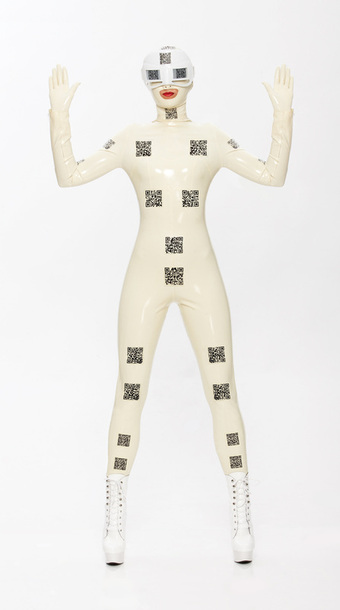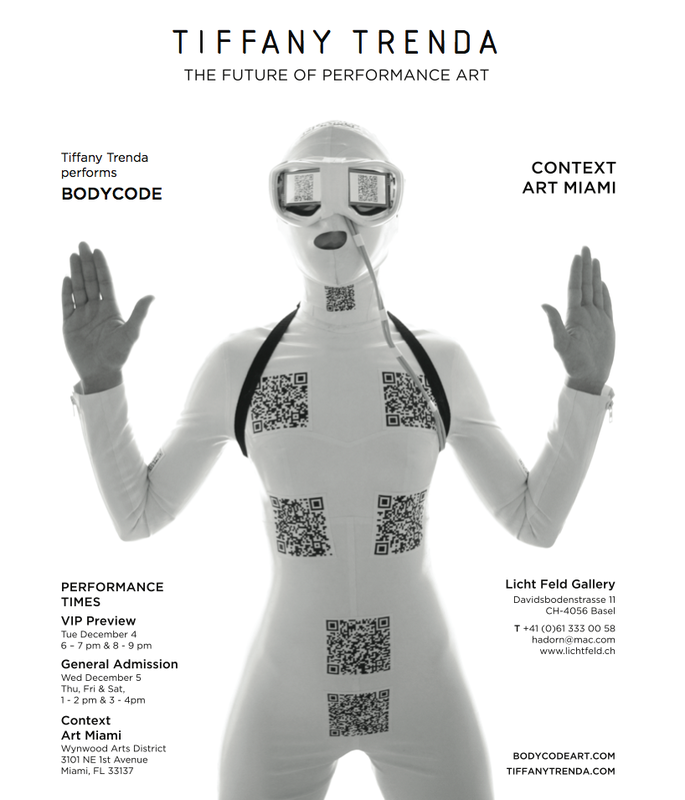
Photo by Glenn Campbell
&LICHT FELD GALLERY, Basel
Her latest work is Body Code. Body Code premieres at Art Miami/Context on December 4, 2012 at a VIP preview from 6 to 7 p.m. and again at 8 to 9 p.m. During regular fair hours performances will take place from 1 to 2 p.m. and 3 to 4 p.m. The performance is presented by Licht Feld Gallery. Work by Trenda will be shown at booth D56.
The piece is an examination of toxicity—of manmade chemicals and how they affect the human body. Trenda employed QR codes to achieve her end. When you scan her body with your cell phone you will be directed to the project website and a page on a particular chemical. The piece is as much about data and technology as it is a cautionary tale on dangerous chemicals.
“One day I was noticing that QR codes are an interesting material because it functions as both an embellishment and a portal into data,” says Trenda. “I started to ponder how can these codes be used in a performance piece that exemplifies this.”
The project has been a journey for Trenda. But the work isn’t just about facts about toxic chemicals it is about process and information in a broader sense.
“Research is always important to my work. So, yes, I did learn more about the toxicity of different chemicals. In retrospect, I was more interested in analyzing the Internet as just pure data,” says Trenda. “Also, during the performance, the audience is not as much interested in what the information actually is but the act, the engagement of scanning is what intrigues people. We are as a culture, are more addicted to the feel of information.”
“The work is interactive by encouraging the viewer to scan my body with their smart phone. This scan from the printed QR codes found on my latex suit, will take them to a certain page found on the Body Code website,” says Trenda. “Depending on where the viewer scans, they will read Google searches consisting of two key words: man-made chemicals and the corresponding part of the body eye, muscle, throat, etc. To partake in this performance, the viewer must download a QR reader (unless you already have one). “
Some examples of QR readers include
-Iphone: QR Reader by TapMedia Ltd
- Droid: QR Pal Blackberry App World
-Supports Most Cell Phones: Quick Mark
“In a more comprehensive approach to the work, the work is about the information itself. For example, when the observer reads a Google search, they can see advertisements about other products that are sometimes in conflict of this significant material. Therefore, valid information becomes a commodity. I also question the rationality of the Internet data,” she says. “So, Body Code is more about the relationship of the human body to the information found on the Internet. In this technology-obsessed culture we live in, we are so accustomed to having data at our fingertips that the content is not as appealing as the act of downloading actually is. I represent this seductive side of data.”
As noted, Trenda uses technologies in her work. There is more to it than pretty lights. There is a forward-looking examination of how the body interacts with technology and where this is ultimately leading.
“My body of work utilizes screen and imaging technologies, such as LCDs and video projections, to create a digital environment with an embodied performance. With these constituents, I make my identity interchangeable by amalgamating screens with my body. How far can we push the visceral qualities of the body until it becomes unrecognizable?” says Trenda. “In my work I become the digitized version of the human body and my actions are replicating that of a computer. The viewer is physically and visually immersed in the process of how the psyche evolves to relate to the screen (LCD, television, cinema, or a computer). We are not only dealing with issues of machine-implemented bodies but our identities and our human connection is through this notion of the screen. “
The discussion of implanting technology into our bodies, not to save our lives but for simple convenience is becoming louder and is soon to be reality. This new world is the context for the artist’s work.
“In my practice, I question the authenticity of this relationship as being a perpetual state of hyperrealism. As technological objects continually become a part of our daily lives, we relate to these devices as if they are part of our skin,” she says. “This will change how we see others and ourselves with the assemblage of the human body with the advancement of new technology. My plans for the future are to continue with this discourse of the mediated body. “
Trenda is from Los Angeles and received her BFA at the Art Center College of Design in Pasadena and her MFA from UCLA. For more information head to the artist’s website, www.tiffanytrenda.com.


 RSS Feed
RSS Feed